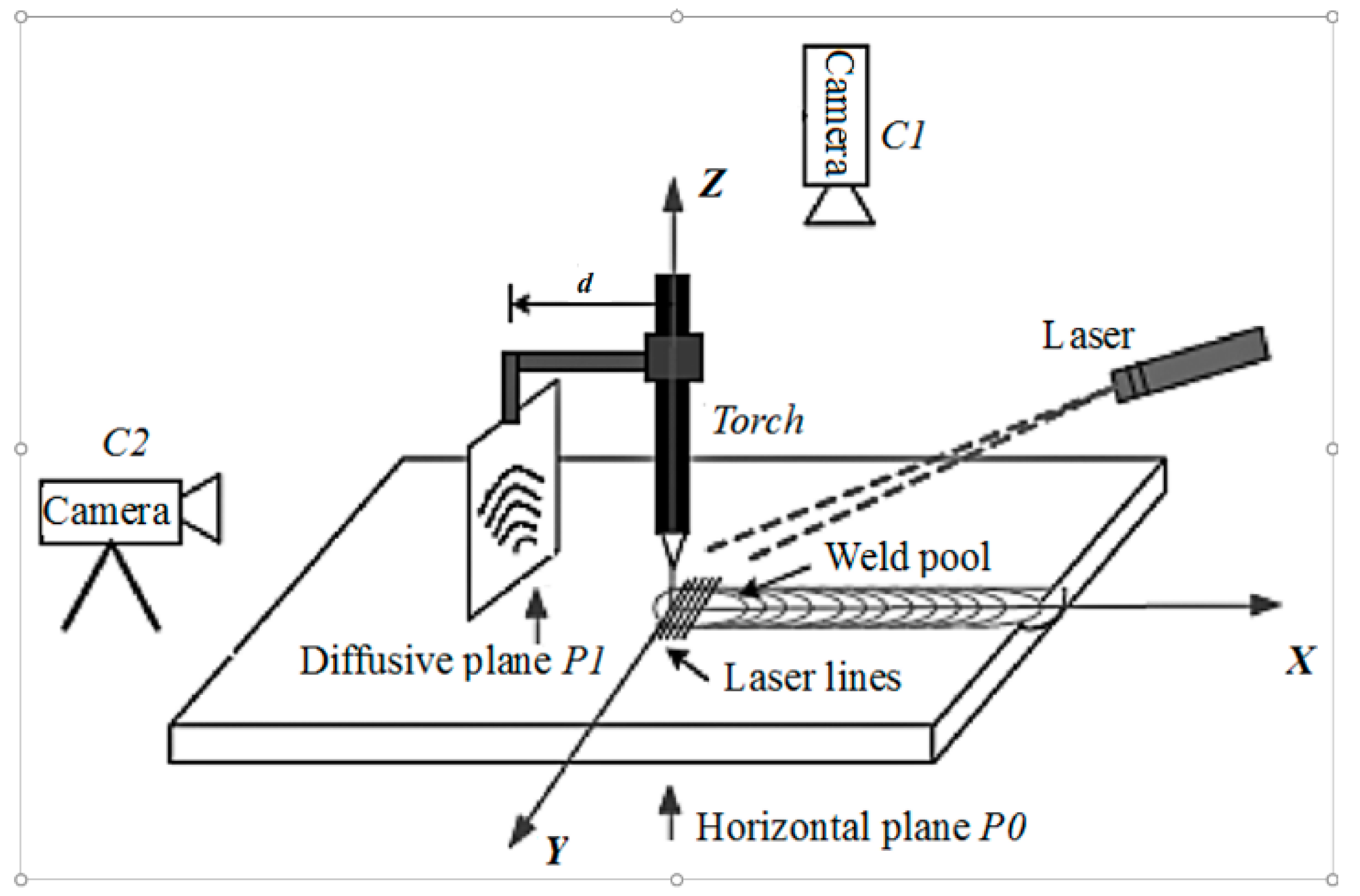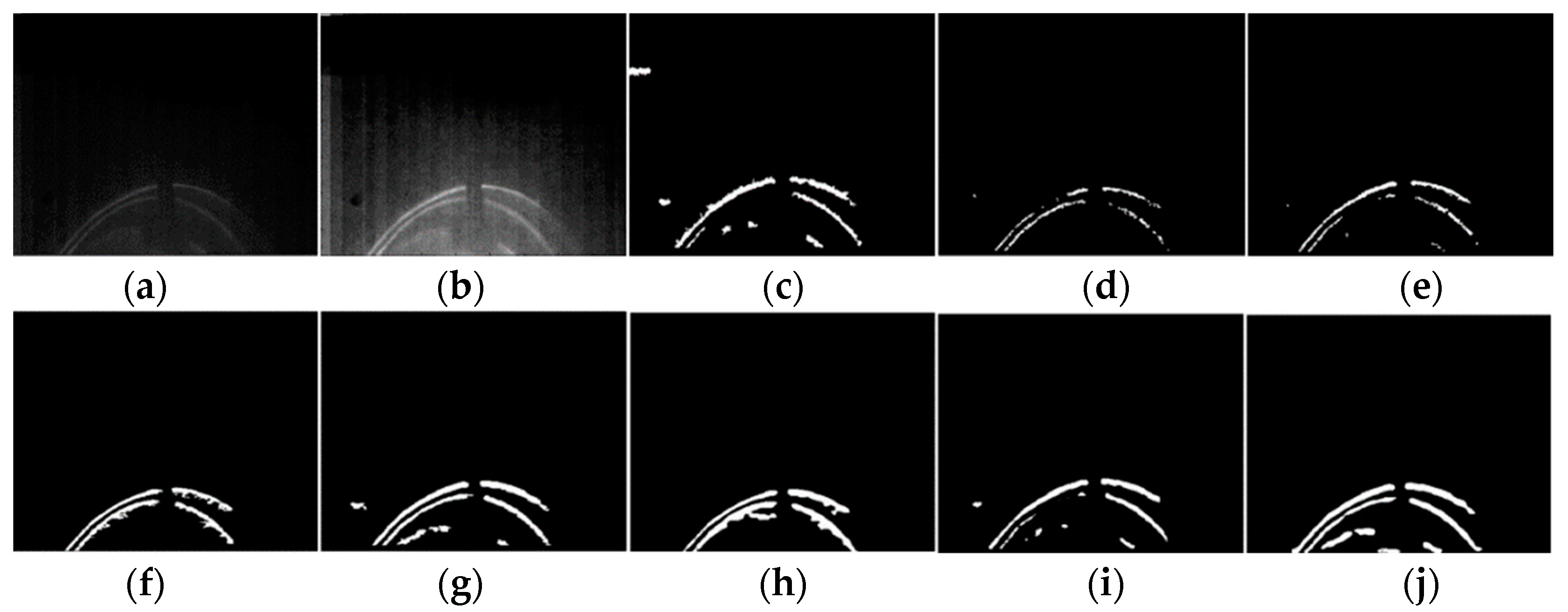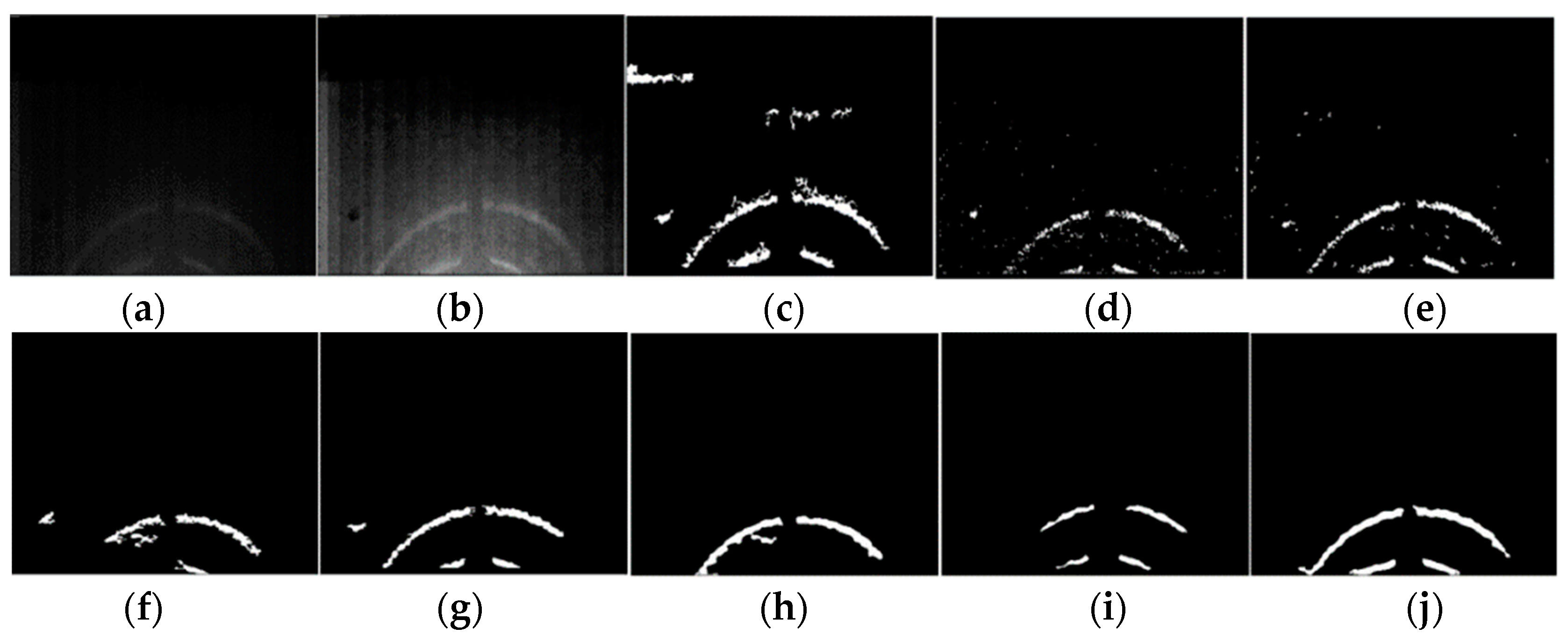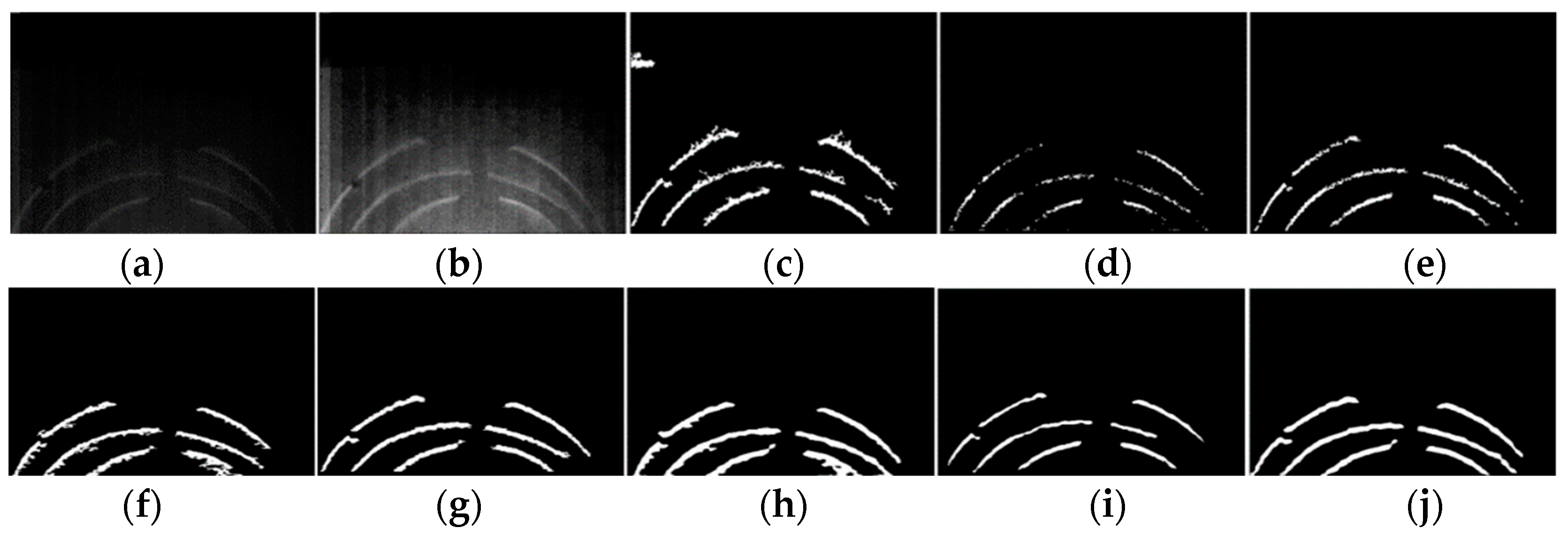Image Segmentation Approaches for Weld Pool Monitoring during Robotic Arc Welding
Abstract
:1. Introduction
2. The Structured Light Monitoring System
3. State of the Art Methods for Laser Line Segmentation
3.1. Top-Hat Transform Based Method
3.2. FFT Filtering Based Method
3.3. Difference Operation Based Method
3.4. Grey Level Co-Occurrence Matrix Based Method
3.5. Combination Method
3.6. Performance Evaluation
4. Analysis of the Combination Approach
5. The Proposed Approaches
6. Results and Discussion
6.1. Experimental Results
6.2. Discussion
- (1)
- We combine the recently proposed image processing algorithms and the traditional GLCM to propose different approaches to segment the reflected laser lines. Their performances including accuracy and processing time are evaluated and compared thoroughly in this paper, which is critical in implementing the on-line weld pool monitoring system;
- (2)
- The image processing algorithms proposed previously are explained theoretically in this paper, which serves as a complementation to the previous research [23];
- (3)
- More efficient segmentation approaches for images captured under mild welding parameters with relatively high quality are proposed in this paper.
7. Conclusions
Author Contributions
Conflicts of Interest
References
- Xu, G.; Hu, J.; Tsai, H.L. Three-dimensional modeling of arc plasma and metal transfer in gas metal arc welding. Int. J. Heat Mass Transf. 2009, 52, 1709–1724. [Google Scholar] [CrossRef]
- Wang, X.X.; Fan, D.; Huang, J.K.; Huang, Y. A unified model of coupled arc plasma and weld pool for double electrodes TIG welding. J. Phys. D Appl. Phys. 2014, 47, 275202. [Google Scholar] [CrossRef]
- Chen, X.H.; Dharmawan, A.G.; Foong, S.H.; Soh, G.S. Seam tracking of large pipe structures for an agile robotic welding system mounted on scaffold structures. Robot. Comput. Integr. Manuf. 2018, 50, 242–255. [Google Scholar] [CrossRef]
- Liu, W.; Li, L.; Hong, Y.; Yue, J. Linear Mathematical Model for Seam Tracking with an Arc Sensor in P-GMAW Processes. Sensors 2017, 17, 591. [Google Scholar] [CrossRef] [PubMed]
- Xu, Y.L.; Lv, N.; Zhong, J.Y.; Chen, H.B.; Chen, S.B. Research on the Real-time Tracking Information of Three-dimension Welding Seam in Robotic GTAW Process Based on Composite Sensor Technology. J. Intell. Robot. Syst. 2012, 68, 89–103. [Google Scholar] [CrossRef]
- Zou, Y.B.; Chen, T. Laser vision seam tracking system based on image processing and continuous convolution operator tracker. Opt. Lasers Eng. 2018, 105, 141–149. [Google Scholar] [CrossRef]
- Chen, Z.; Chen, J.; Feng, Z. Monitoring Weld Pool Surface and Penetration Using Reversed Electrode Images. Weld. J. 2017, 96, 367S–375S. [Google Scholar]
- Lv, N.; Zhong, J.Y.; Chen, H.B.; Lin, T.; Chen, S.B. Real time control of welding penetration during robotic GTAW dynamical process by audio sensing of arc length. Int. J. Adv. Manuf. Technol. 2014, 74, 235–249. [Google Scholar] [CrossRef]
- Li, C.K.; Shi, Y.; Du, L.M.; Gu, Y.F.; Zhu, M. Real-time Measurement of Weld Pool Oscillation Frequency in GTAW-P Process. J. Manuf. Process. 2017, 29, 419–426. [Google Scholar] [CrossRef]
- Yang, M.X.; Yang, Z.; Cong, B.Q.; Qi, B. A Study on the Surface Depression of the Molten Pool with Pulsed Welding. Weld. J. 2014, 93, 312S–319S. [Google Scholar]
- Ko, S.H.; Choi, S.K.; Yoo, C.D. Effects of surface depression on pool convection and geometry in stationary GTAW. Weld. J. 2001, 80, 39. [Google Scholar]
- Qi, B.J.; Yang, M.X.; Cong, B.Q.; Liu, F.J. The effect of arc behavior on weld geometry by high-frequency pulse GTAW process with 0Cr18Ni9Ti stainless steel. Int. J. Adv. Manuf. Technol. 2013, 66, 1545–1553. [Google Scholar] [CrossRef]
- Rokhlin, S.; Guu, A. A study of arc force, pool depression and weld penetration during gas tungsten arc welding. Weld. J. 1993, 72, S381–S390. [Google Scholar]
- Zhang, Y.M.; Li, L.; Kovacevic, R. Dynamic estimation of full penetration using geometry of adjacent weld pools. J. Manuf. Sci. Eng. 1997, 119, 631–643. [Google Scholar] [CrossRef]
- Kovacevic, R.; Zhang, Y.M. Real-time image processing for monitoring of free weld pool surface. J. Manuf. Sci. Eng. 1997, 119, 161–169. [Google Scholar] [CrossRef]
- Saeed, G.; Lou, M.J.; Zhang, Y.M. Computation of 3D weld pool surface from the slope field and point tracking of laser beams. Meas. Sci. Technol. 2004, 15, 389–403. [Google Scholar] [CrossRef]
- Zhang, W.J.; Wang, X.W.; Zhang, Y.M. Analytical real-time measurement of three-dimensional weld pool surface. Meas. Sci. Technol. 2013, 24, 115011. [Google Scholar] [CrossRef]
- Zhang, Y.M.; Song, H.S.; Saeed, G. Observation of a dynamic specular weld pool surface. Meas. Sci. Technol. 2006, 17, 9–12. [Google Scholar] [CrossRef]
- Ma, X.J.; Zhang, Y.M. Gas tungsten arc weld pool surface imaging: Modeling and processing. Weld. J. 2011, 90, 85–94. [Google Scholar]
- Shi, Y.; Zhang, G.; Ma, X.J.; Gu, Y.F.; Huang, J.K.; Fan, D. Laser-vision-based measurement and analysis of oscillation frequency in GMAW-P. Weld. J. 2015, 94, 176–187. [Google Scholar]
- Wang, Z.Z. Monitoring of GMAW weld pool from the reflected laser lines for real time control. IEEE Trans. Ind. Inform. 2014, 10, 2073–2083. [Google Scholar] [CrossRef]
- Wang, Z.Z. An imaging and measurement system for robust reconstruction of weld pool during arc welding. IEEE Trans. Ind. Electron. 2015, 62, 5109–5118. [Google Scholar] [CrossRef]
- Wang, Z.Z. Unsupervised recognition and characterization of the reflected laser lines for robotic gas metal arc welding. IEEE Trans. Ind. Inform. 2017, 13, 1866–1876. [Google Scholar] [CrossRef]
- Dougherty, E.R. An Introduction to Morphological Image Processing; SPIE International Society for Optical Engine: Bellingham, WA, USA, 1992. [Google Scholar]
- Edelman, A.; Mccorquodale, P.; Toledo, S. The future fast Fourier transform. SIAM J. Sci. Comput. 1999, 20, 1094–1114. [Google Scholar] [CrossRef]
- Haralick, R.M.; Shanmugam, K.; Dinstein, I. Textural Features for Image Classification. IEEE Trans. Syst. Man Cybern. 1973, 6, 610–621. [Google Scholar] [CrossRef]
- Grossberg, M.; Nayar, S. Determining the Camera Response from Images: What is Knowable? IEEE Trans. Pattern Anal. Mach. Intell. 2003, 25, 1455–1467. [Google Scholar] [CrossRef]












| Approaches | F-Measure |
|---|---|
| Approach 1 | 0.5380 |
| Approach 2 | 0.2074 |
| Approach 3 | 0.2276 |
| Approach 4 | 0.5011 |
| Approach 5 | 0.8546 |
| Approach 6 | 0.4743 |
| Approach 7 | 0.4469 |
| Approach 8 | 0.9176 |
| Approaches | Computation Time |
|---|---|
| Approach 7 | 0.05 s |
| Approach 3 | 0.045 s |
| Approach 2 | 0.042 s |
| Approach 8 | 0.031 s |
| Approach 6 | 0.028 s |
| Approach 5 | 0.0145 s |
| Approach 4 | 0.0138 s |
| Approach 1 | 0.01 s |
© 2018 by the authors. Licensee MDPI, Basel, Switzerland. This article is an open access article distributed under the terms and conditions of the Creative Commons Attribution (CC BY) license (http://creativecommons.org/licenses/by/4.0/).
Share and Cite
Wang, Z.; Zhang, C.; Pan, Z.; Wang, Z.; Liu, L.; Qi, X.; Mao, S.; Pan, J. Image Segmentation Approaches for Weld Pool Monitoring during Robotic Arc Welding. Appl. Sci. 2018, 8, 2445. https://doi.org/10.3390/app8122445
Wang Z, Zhang C, Pan Z, Wang Z, Liu L, Qi X, Mao S, Pan J. Image Segmentation Approaches for Weld Pool Monitoring during Robotic Arc Welding. Applied Sciences. 2018; 8(12):2445. https://doi.org/10.3390/app8122445
Chicago/Turabian StyleWang, Zhenzhou, Cunshan Zhang, Zhen Pan, Zihao Wang, Lina Liu, Xiaomei Qi, Shuai Mao, and Jinfeng Pan. 2018. "Image Segmentation Approaches for Weld Pool Monitoring during Robotic Arc Welding" Applied Sciences 8, no. 12: 2445. https://doi.org/10.3390/app8122445




